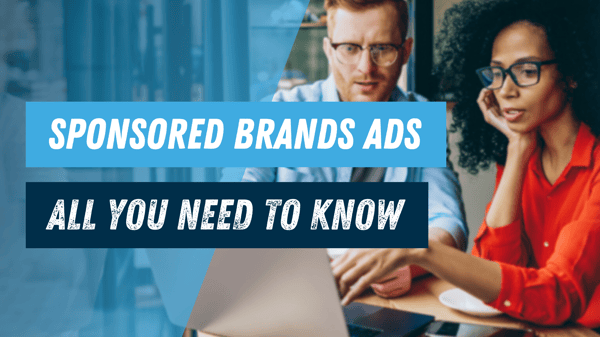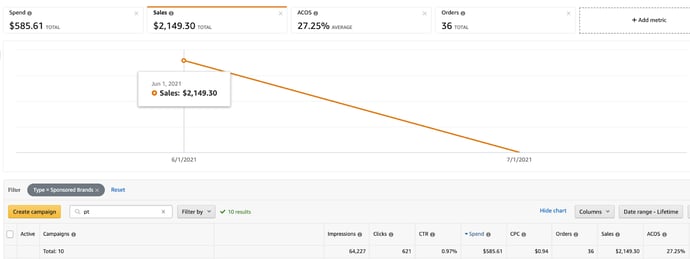 Sponsored Brand ads are a customizable cost-per-click ad format for the Amazon marketplace. They allow brands to showcase their products with a custom title or a single product alongside a video.
Sponsored Brand ads are a customizable cost-per-click ad format for the Amazon marketplace. They allow brands to showcase their products with a custom title or a single product alongside a video.
In today’s post, Bobsled’s Emmanuel Akpan has explained how and why the Sponsored Brand format engages customers in a way that Amazon's other sponsored ads solutions don't.

Sponsored Brands Ads Formats
Advertisers can choose between showcasing three products, a storefront, and sub-pages, or a single product and an accompanying video.
Above: 3 different SB ad format options
These Sponsored Brand placements are located:
- Top of search (Product Collection, Store Spotlight)
- Product detail page (Product Collection)
- Bottom of search (Product Collection, Store Spotlight)
- Within search results (Video Ads)
Above: Example of SB Video ads within search results
Above: Example of SB Product Collection Ads in the search footer
On the left: Top of Search Product Collection (mobile placement) ads featuring a custom image
Benefits of Sponsored Brands ads
Brands can set up and adjust campaigns to achieve and their specific goals and targets.
Brand Awareness on Amazon
Unlike the other Amazon Sponsored Ads solutions, the customizable ad creative allows brands to build awareness by engaging shoppers using a branded logo and custom image and title. Advertisers have the ability to feature recognizable, hero products alongside a logo and custom brand image.
Above: Example of Bulletproof using their logo and hero products to build awareness among shoppers searching in the category.
On the left: Ember has used lifestyle custom images to build awareness and brand affinity among shoppers searching in category.
Using SB ads helped Bobsled grow new-to-brand sales (first-time purchasers) for a haircare brand.
Amazon’s NTB metrics illustrate the effectiveness of your brand awareness SB campaigns.
Above: Notice the spike in NTB sales when Bobsled began implementing SB ads at the beginning of 2019
💡 Tips for building brand awareness using SB ads:
- Modifiers. Include the plus sign (+) when broad targeting keywords
- Brand Keyword Split. Split these campaigns by brand and non-brand keywords (mixing brand and non-brand can muddy true performance)
- Use negatives. Reduce visibility to irrelevant customers
Speak To Your Customers (and what they’re searching for)
Maximize the conversion opportunity from your SB ads, and avoid leaving potential sales on the table, by taking full advantage of the customizable fields to improve your conversion rates. This is particularly important for brands that want to grow sales while improving or maintaining profitability.
- Download your search term reports and identify top-performing search terms
- Create separate campaigns targeting these search terms as keywords.
- Be sure to match your headline titles to these keywords.
Ads that speak directly to customer searches convert better and will improve your spend efficiency.
Keep seasonality top of mind
Brands with seasonal and giftable products need to keep a close eye on shifting search trends. Take full advantage by modifying the customizable fields within your SB ads to effectively and profitably grow sales during these vital periods.
Targeting keywords related to occasions/season, and making the titles relevant to those keywords is especially important for budget-conscious brands that want to profitably grow sales in very competitive categories.
A Bobsled client selling in the Beauty space typically observes spikes during gifting seasons. They capitalized on running SB ads in the lead up to Mother’s Day generating close to $400 in new to brand sales at a 23% ACoS (40% ACoS is typical during non-peak periods is typical due to the competitiveness of the category).
Above: Be prepared to capitalize with custom SB ads when impressions spike during peak seasons
💡 Tips for using SB ads that speak to specific searches:
- Feature your most relevant products/store pages in your ad (e.g. feature more giftable products on campaigns focused around gift seasons)
- Make your creative as relevant as possible (e.g. use lifestyle images featuring couples in custom images for Valentines Day campaigns, use a Christmas-themed variation of your logo in November and early December, etc)
Sponsored Brands ads and product targeting
Product targeting allows brands to put PPC ads on product display pages with Sponsored Brands ads.
Attack and defend with product targeting (to build a cohesive brand experience)
Product targeting allows brands to strategically ‘attack’ competitors' products to drive awareness and sales growth.
Simultaneously, brands can use Sponsored Brands ads to ‘defend’ their product pages from competitor ads. Targeting your own listings with SB ads and video ads creates a consistent experience for shoppers and prevents competitors ‘stealing’ your hard-earned traffic.
Identify competitor weak spots
Capitalize when you have a clear social proof advantage over the competition. For example, the Bobsled PPC team targeted a competitors’ listing that had a lower star rating and review count compared to a Bobsled client in the same category. This brand was able to generate an extra $2,134 in sales at a 27% ACoS.

💡 Tips for product-targeted SB ads:
- Qualitatively assess the competitors you target to effectively and profitably drive sales
- When building awareness ensure ad creative is high quality and engaging to captivate shoppers
- Identify which of your own listings are most attacked by competitors, make owning these ASINs the priority when developing a defensive targeting strategy
Own more market share today by harnessing Sponsored Brands ads!
Sponsored Brands are an essential part of any brand’s growth strategy on Amazon. Bobsled has a number of different levers we can pull to tailor and optimize performance no matter the account size, budget, or competitive standing.

Tagged: PPC Advertising, Amazon Account Management, Amazon Display Advertising
.png)

